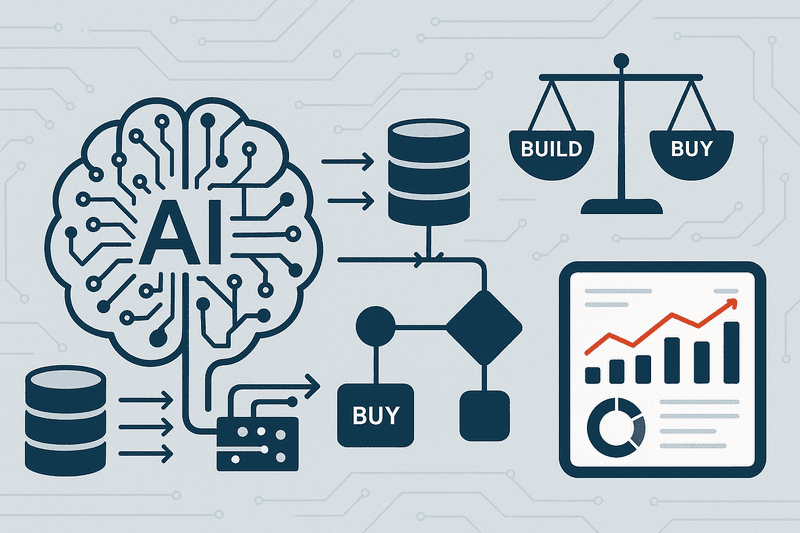The Data Standardization Imperative
In the rush to implement artificial intelligence solutions, many organizations overlook a fundamental prerequisite: data standardization. Without a unified approach to data structure, classification, and governance, AI initiatives are built on unstable foundations that inevitably lead to suboptimal outcomes, wasted resources, and missed opportunities.
Data standardization refers to the process of creating consistent formats, structures, and definitions for data across an organization. This includes establishing common schemas, naming conventions, data types, and quality standards that enable different systems and departments to communicate effectively. For AI systems, which rely heavily on pattern recognition and statistical analysis, standardized data is not just beneficial—it's essential.
Why AI Demands Standardized Data
AI algorithms are only as good as the data they're trained on. When data comes from multiple sources with different formats, structures, and quality levels, AI systems struggle to identify meaningful patterns. Inconsistent data leads to biased models, inaccurate predictions, and unreliable outputs. Machine learning models trained on unstandardized data often fail to generalize across different business units or use cases, limiting their effectiveness and return on investment.
The Hidden Costs of Data Fragmentation
Organizations with fragmented data architectures face significant hidden costs. Data scientists spend 60-80% of their time on data preparation rather than model development. Multiple versions of 'truth' exist across departments, leading to conflicting insights and decision paralysis. Integration costs skyrocket as each new AI initiative requires custom data connectors and transformation logic. Most critically, the time-to-value for AI projects extends dramatically when data standardization is an afterthought rather than a prerequisite.
The Subsidiary Data Classification Challenge
Consider a multinational corporation with subsidiaries across different regions and industries. Each subsidiary has evolved its own data classification systems, creating a complex web of incompatible data structures that severely hampers AI implementation.
A Real-World Example: Customer Classification Chaos
Imagine a parent company with three subsidiaries: a retail chain in North America, a manufacturing division in Europe, and a services company in Asia. Each subsidiary classifies customers differently:
•North American Retail: Customers are classified as 'Premium' (>$10,000 annual spend), 'Standard' ($1,000-$10,000), and 'Basic' (<$1,000). Customer records include fields like 'purchase_frequency', 'loyalty_tier', and 'preferred_channel'.
•European Manufacturing: Customers are classified as 'Enterprise' (B2B contracts >€50,000), 'SME' (small-medium enterprises), and 'Individual' (one-time buyers). Their system uses 'contract_value', 'industry_sector', and 'payment_terms'.
•Asian Services: Customers are segmented as 'Corporate' (multi-year contracts), 'Project-based' (single engagements), and 'Consultation' (advisory services). They track 'engagement_duration', 'service_category', and 'renewal_probability'.
The Cascading Problems
When the parent company attempts to implement a global AI system for customer lifetime value prediction, these classification differences create multiple critical issues:
•Semantic Confusion: What constitutes a 'premium' customer varies dramatically across subsidiaries. The AI system cannot determine if a €60,000 manufacturing client is equivalent to a $12,000 retail customer.
•Missing Data Dimensions: The retail system lacks B2B contract information, while the manufacturing system has no loyalty program data. The AI model is forced to make predictions with incomplete feature sets.
•Incompatible Metrics: Revenue thresholds, currency differences, and industry-specific KPIs make it impossible to create unified customer scoring models.
•Training Data Bias: Each subsidiary's historical data reflects their unique market conditions and business models, creating biased training sets that don't generalize across the organization.
The Business Impact
These data classification inconsistencies result in:
•Failed AI Initiatives: Customer segmentation models that work in one region fail completely in others, leading to poor targeting and reduced ROI.
•Operational Inefficiencies: Sales teams receive conflicting customer insights, leading to misaligned strategies and lost opportunities.
•Compliance Risks: Different data handling practices across subsidiaries create regulatory compliance gaps, particularly problematic for GDPR and other data protection regulations.
•Strategic Blindness: Executive leadership lacks unified customer insights, making it difficult to make informed strategic decisions about market expansion or product development.
Building the Translational Layer
When complete data standardization isn't immediately feasible, organizations must implement robust translational layers that can bridge the gap between disparate data sources and AI systems. This middleware approach enables AI implementation while longer-term standardization efforts are underway.
Data Transformation Architecture
A translational layer consists of several key components:
•Schema Mapping: Create detailed mappings between different data schemas, defining how fields from source systems correspond to standardized target schemas. This includes handling data type conversions, field concatenations, and derived calculations.
•Data Validation Rules: Implement comprehensive validation logic that ensures data quality and consistency across all sources. This includes range checks, format validation, and business rule enforcement.
•Master Data Management: Establish authoritative reference data that defines standard values, classifications, and hierarchies. This ensures consistent interpretation of categorical data across different sources.
•Real-time Synchronization: Deploy change data capture mechanisms that ensure the translational layer reflects the most current state of source systems, maintaining data freshness for AI applications.
Implementation Strategies
Successful translational layer implementation requires careful planning and execution:
•Phased Rollout: Begin with critical business processes and high-value use cases, gradually expanding coverage as confidence and expertise grow.
•Data Lineage Tracking: Maintain comprehensive audit trails that document data transformations, enabling troubleshooting and regulatory compliance.
•Performance Optimization: Design the translational layer for scalability, implementing caching strategies and distributed processing to handle enterprise-scale data volumes.
•Error Handling: Build robust exception handling and data quality monitoring to identify and address issues before they impact AI system performance.
Governance and Maintenance
The translational layer requires ongoing governance to remain effective:
•Version Control: Maintain strict version control for transformation logic, enabling rollback capabilities and change tracking.
•Testing Protocols: Implement comprehensive testing procedures for all data transformations, including unit tests, integration tests, and data quality assessments.
•Documentation Standards: Maintain detailed documentation of all mapping rules, business logic, and data definitions to ensure knowledge transfer and system maintainability.
•Performance Monitoring: Continuously monitor system performance, data quality metrics, and transformation success rates to identify optimization opportunities.
Data Tagging and Classification Systems
Effective data tagging and classification systems are fundamental to successful AI implementation. These systems provide the metadata framework that enables AI systems to understand data context, relationships, and appropriate usage patterns.
Metadata-Driven AI
Modern AI systems increasingly rely on rich metadata to improve performance and interpretability:
•Semantic Tags: Descriptive labels that explain the meaning and context of data elements. For example, tagging a field as 'customer_acquisition_date' provides context that raw field names like 'date_1' cannot convey.
•Quality Indicators: Metadata that describes data quality characteristics, including accuracy levels, completeness scores, and freshness timestamps. This enables AI systems to weight data appropriately during model training.
•Lineage Information: Tags that trace data origin, transformation history, and processing steps. This metadata is crucial for model explainability and regulatory compliance.
•Usage Constraints: Classification tags that indicate appropriate usage patterns, privacy levels, and regulatory restrictions. This ensures AI systems comply with data governance policies.
Classification Taxonomies
Robust classification systems require well-designed taxonomies that balance granularity with usability:
•Hierarchical Structures: Multi-level classification systems that allow for both broad categorization and detailed sub-classification. For example: Financial Data > Customer Data > Transaction Data > Payment Method.
•Domain-Specific Vocabularies: Industry-specific classification schemes that reflect business context and regulatory requirements. Healthcare organizations might use HL7 FHIR classifications, while financial services might adopt FIBO (Financial Industry Business Ontology).
•Multi-dimensional Tagging: Systems that support multiple, overlapping classification schemes, allowing data to be categorized by sensitivity level, business domain, geographic region, and data type simultaneously.
•Dynamic Classification: Adaptive systems that can automatically classify new data based on content analysis, pattern recognition, and machine learning algorithms.
Implementation Best Practices
Successful data tagging initiatives require careful planning and execution:
•1. Start with Business Value: Focus initial tagging efforts on high-value data sets that directly support critical AI use cases.
•2. Automate Where Possible: Implement automated classification systems that can handle routine categorization tasks, reserving human effort for complex or ambiguous cases.
•3. Maintain Consistency: Establish clear governance processes that ensure consistent application of classification rules across the organization.
•4. Enable Discovery: Build search and discovery tools that leverage metadata to help users and AI systems find relevant data quickly and efficiently.
Modern Data Repository Solutions
The choice of data repository architecture significantly impacts AI system performance and organizational agility. Modern solutions must balance performance, scalability, governance, and accessibility requirements.
Data Lake Architecture
Data lakes provide flexible storage for diverse data types and formats:
•Schema-on-Read: Data lakes store raw data without predefined schemas, allowing for flexible analysis and exploration. This approach supports AI experimentation and rapid prototyping.
•Multi-format Support: Native support for structured, semi-structured, and unstructured data enables comprehensive AI training datasets that include text, images, logs, and traditional tabular data.
•Cost-Effective Storage: Cloud-based data lakes offer virtually unlimited storage capacity at low costs, making them ideal for organizations with large data volumes.
However, data lakes require strong governance to prevent becoming 'data swamps' where valuable information becomes difficult to find and use effectively.
Data Warehouse Solutions
Traditional data warehouses excel at structured data processing and reporting:
•Performance Optimization: Columnar storage, indexing, and query optimization techniques provide fast access to large datasets, crucial for real-time AI applications.
•Data Quality: ETL processes ensure data consistency and quality before storage, providing clean training data for AI models.
•Business Intelligence Integration: Native integration with reporting and analytics tools enables seamless transition from traditional BI to AI-powered insights.
Modern cloud data warehouses like Snowflake, Amazon Redshift, and Google BigQuery offer elastic scaling and native machine learning capabilities.
Hybrid Lake-House Architectures
Lake-house architectures combine the flexibility of data lakes with the performance of data warehouses:
•Delta Lake and Iceberg: Open-source table formats that bring ACID transactions, schema evolution, and time travel capabilities to data lakes.
•Unified Analytics: Single platform for batch processing, stream processing, and machine learning, reducing data movement and complexity.
•Performance Benefits: Optimized file formats and caching strategies provide warehouse-like performance for analytical workloads.
•Governance Integration: Built-in data lineage, access controls, and audit capabilities ensure compliance while maintaining flexibility.
Specialized AI Repositories
Purpose-built repositories for AI workloads offer optimized performance and functionality:
•Feature Stores: Centralized repositories for machine learning features that ensure consistency between training and inference environments. Examples include Feast, Tecton, and AWS SageMaker Feature Store.
•Model Registries: Version-controlled repositories for trained models, including metadata, performance metrics, and deployment artifacts. MLflow, Kubeflow, and cloud-native solutions provide comprehensive model lifecycle management.
•Vector Databases: Specialized databases optimized for similarity search and embedding storage, crucial for AI applications involving natural language processing and recommendation systems. Examples include Pinecone, Weaviate, and Milvus.
•Graph Databases: Repositories optimized for relationship-rich data, enabling AI applications that leverage network effects and complex entity relationships. Neo4j, Amazon Neptune, and ArangoDB provide sophisticated graph processing capabilities.
Implementation Roadmap
Successfully implementing data standardization for AI requires a structured approach that balances immediate needs with long-term strategic goals.
Phase 1: Assessment and Planning
The first phase focuses on understanding current state and establishing foundations:
•Data Inventory: Conduct comprehensive assessment of existing data sources, formats, and quality levels across the organization.
•Use Case Prioritization: Identify high-value AI use cases that will benefit most from standardized data, focusing on quick wins that demonstrate value.
•Stakeholder Alignment: Engage business leaders, IT teams, and data users to establish shared understanding of standardization goals and requirements.
•Governance Framework: Establish data governance policies, roles, and responsibilities that will guide standardization efforts.
Phase 2: Foundation Building
The second phase focuses on establishing core infrastructure and processes:
•Master Data Management: Implement MDM solutions for critical business entities like customers, products, and suppliers.
•Data Quality Framework: Deploy data quality monitoring and improvement processes to ensure clean, reliable data for AI systems.
•Metadata Management: Establish comprehensive metadata repositories that support data discovery and understanding.
•Initial Standardization: Begin with high-impact data domains that support priority AI use cases.
Phase 3: Scaling and Optimization
The third phase focuses on scaling initiatives and optimizing performance:
•Automated Classification: Implement AI-powered data classification systems that can handle routine categorization tasks.
•Advanced Analytics: Deploy sophisticated data profiling and analysis tools that identify standardization opportunities.
•Performance Optimization: Tune repository performance and access patterns to support production AI workloads.
•Continuous Improvement: Establish feedback loops that drive ongoing refinement of standardization practices.
Success Metrics
Measuring the success of data standardization initiatives requires comprehensive metrics:
•Data Quality Metrics: Track improvements in data accuracy, completeness, and consistency across the organization.
•AI Performance Indicators: Monitor model accuracy, training efficiency, and deployment success rates as measures of standardization effectiveness.
•Operational Efficiency: Measure reductions in data preparation time, integration costs, and time-to-value for AI projects.
•Business Impact: Evaluate improvements in decision-making quality, customer satisfaction, and competitive advantage driven by standardized data and AI capabilities.





